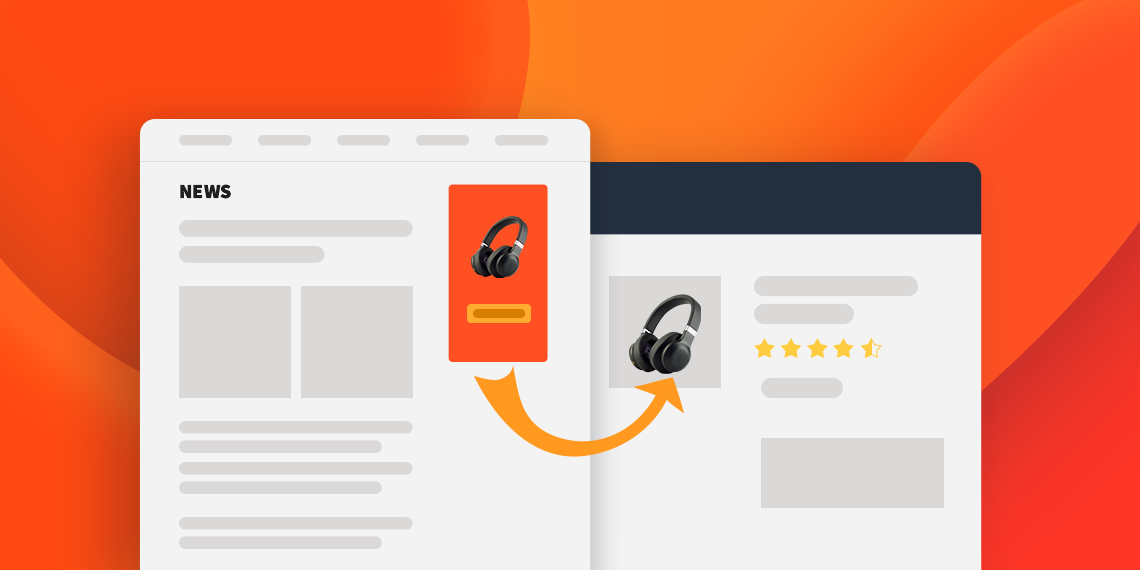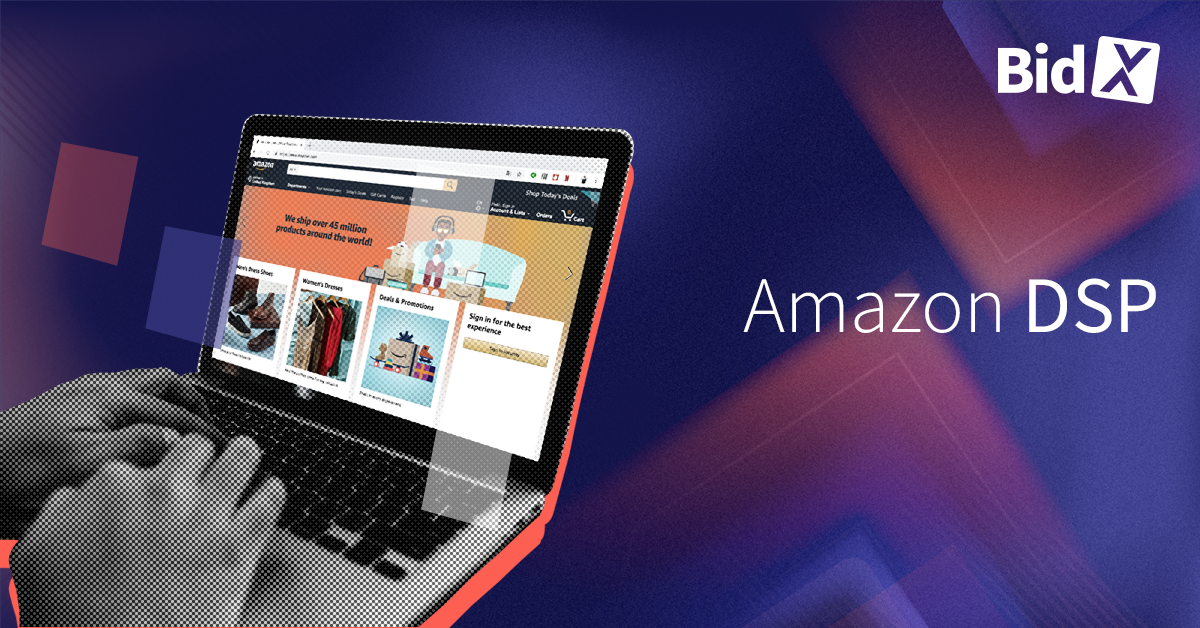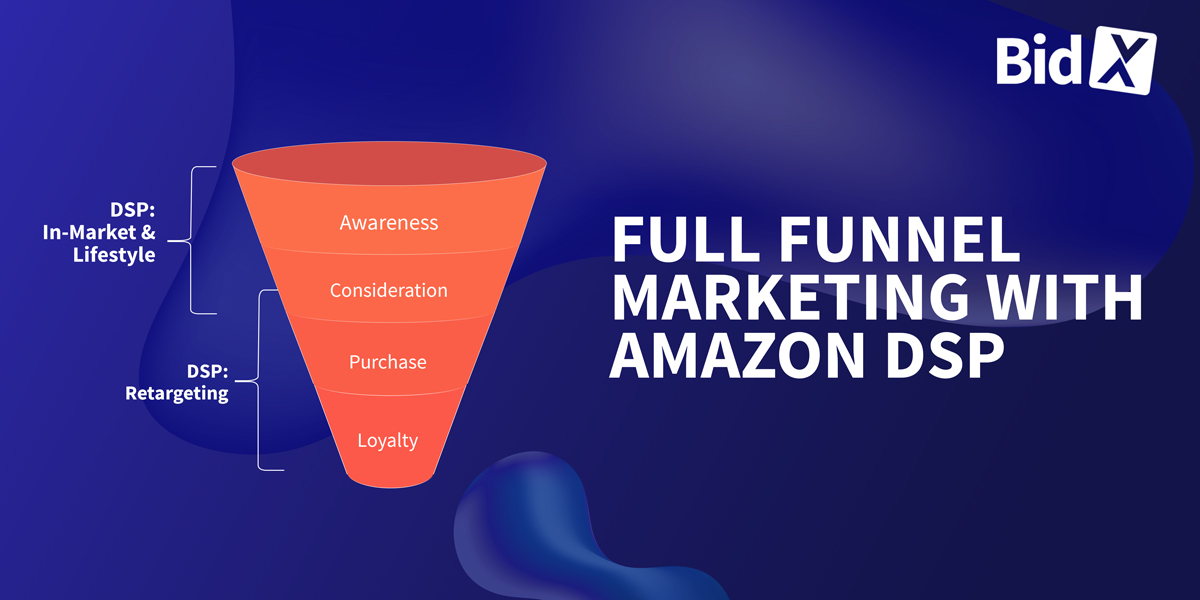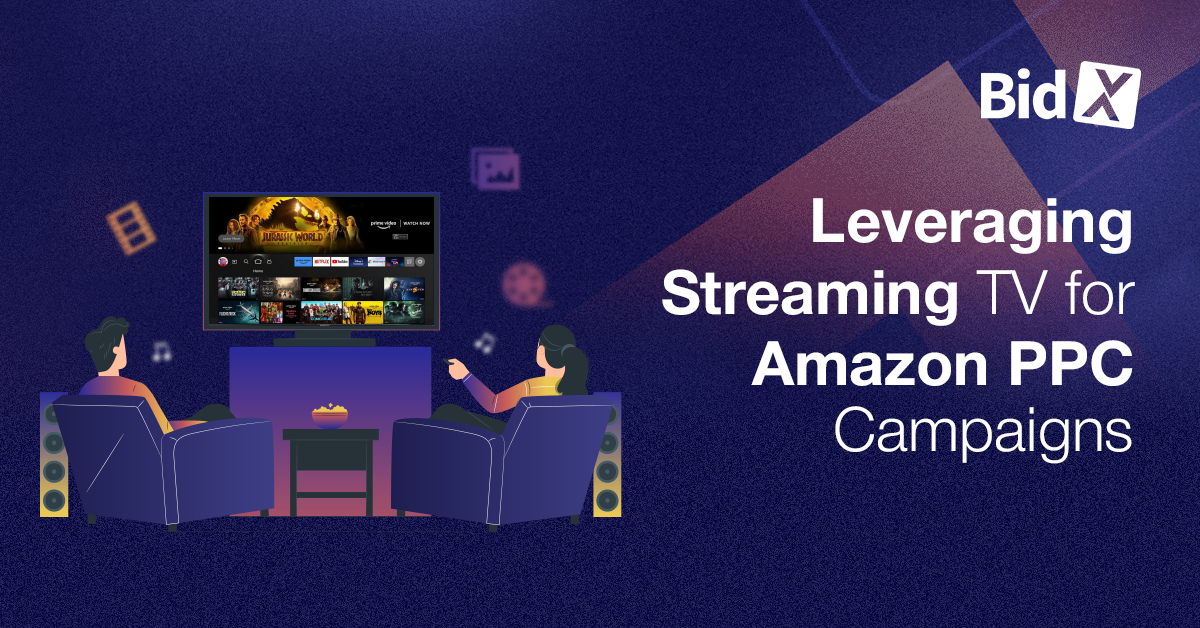Does Amazon DSP make sense for my company?
In this article, we give you an insight into the use of DSP and why it can be worthwhile for you and your company.
- What is Amazon DSP?
- Functionality of Amazon DSP
- Advertising forms and placements
- Display ads
- Video ads
- Differences to Amazon PPC advertisements
- Placement
- Linking
- Seller status
- Billing model
- Design options
- Sales funnel audience
- DSP registration and format creation
- Managed-service
- Enterprise self-service
- Registration process
- DSP - advantages and disadvantages
- Advantages
- Disadvantages
- DSP recommendation - YES or NO?
What is Amazon DSP?
DSP stands for "Demand-side Platform". It is a platform on which companies can programmatically book placements for display and video advertisements on websites, including both Amazon and non-Amazon sites.
The principle is similar to the Google Display Network (GDN). There, too, advertising space can be purchased for a variety of websites. The advantage of these platforms is that you don't have to book ad spaces on each website individually, but instead your ads are automatically displayed on several websites belonging to the network. You can choose a target group for the more targeted placement of your ads on websites which share a common theme.
The big advantage of Amazon DSP compared to other advertising networks is that Amazon has access to considerable data on the purchasing behaviour of customers. This is worth its weight in gold for you as an advertiser, because you can reach your audience in a much more targeted way when their search and purchase history is known. For example, you can reach people on the internet who have already bought products similar to yours, with the probability that your advertisement will be noticed by these people relatively high, as it can be assumed that they have a concrete interest in the product category.
Indeed, a special feature of Amazon DSP is that you do not have to sell on Amazon to use the DSP. In any case, a DSP is of more interest to companies with a certain advertising budget: the platform can be used either via a managed service provided by Amazon with a requisite minimum budget (10,000 EUR per month in the EU or 35,000 USD per month in North America), or via a registered DSP partner, such as BidX, which often requires a lower minimum budget (we recommend 5,000 EUR per month). For more information, see the section "DSP registration and format creation".
Functionality of Amazon DSP
As mentioned above, Amazon DSP can be used to display advertisements on both Amazon's own websites and third-party websites, with the Amazon Publisher Services (APS) service delivering ads to third-party websites that are not part of Amazon’s platforms.
Precise targeting capabilities are one of the advantages of the DSP. Users can choose from a variety of targeting options and thus decide who will see their ads in the future. We will briefly introduce these options here.
Retargeting
Retargeting allows you to reach people who have already interacted with your products or those of your competitors. Interactions can be "searches" or page views of product detail pages with or without purchase completion. This means that you can target people who have viewed certain products from you or your competitors and let them see your ads on other websites. The advantage of this is that you can assume that they are interested in your product. Furthermore, you can place similar products, or products that complement the products they have seen, within your advertisement.
Lifestyle
You can also select your target group on the basis of certain lifestyle segments. These groups are based on the Amazon search and purchase data of customers. Amazon uses this data to create a user profile of each customer by assigning lifestyle groups to them which relate to their purchases. For example, if a customer has bought a lot of sportswear in the past or has often searched for sports equipment, Amazon will probably assign him or her to a lifestyle such as "sporty". These defined lifestyles can be selected by you as an advertiser to display your ads specifically for people with lifestyles relevant to your products.
Behavioral
The targeting option "Behavioral" also takes into account the buying and search behavior of Amazon customers. Thus, your ads will be displayed when people show the behaviour you have previously selected as being relevant to your products. For example, you can select certain interests so that as soon as a customer's online behaviour matches with any of these interests, they are automatically assigned to your target group and will see your ads. For example, if you sell yoga mats, your ad can be displayed to people who have searched for yoga clothing.
Lookalike Audience
You also have the possibility to reach people who behave similarly to a group you have chosen - a so-called “lookalike audience”. For example, if you create a lookalike audience of your customers, your ads will be displayed to people who are similar to your existing customers, i.e. who have a similar search and buying behavior to your customers. This is possible due to the large amount of data Amazon collects from its many users, and is especially useful if you do not sell on Amazon. Via a pixel you can record certain events on your website and, for example, create a lookalike audience based on the most recent new customers.
Content
When using data for targeting, it is not just data on customer behaviour on the Amazon platform which is used. Customer search behavior on other websites is also taken into account for specific targeting. This means that you can target people who show an interest in a subject to which your advertised product relates, regardless of whether they showed such interest on Amazon's platform specifically or on a completely different website. If we stick to the example of the yoga mat, your ad can therefore be displayed to people who, for example, have accessed blog articles on yoga topics.
Advertisers Audience
You can also select and target a target group based on your own data, such as existing customers of your website. To do this, you must upload data from your Data Management Platform (DMP) to the DSP.
Other options
In addition, advertisers can further narrow down their target group on the basis of other characteristics, e.g. on the basis of demographics by providing information on age and gender. Selections can also be made according to browser choice or device used, e.g. to have ads displayed on certain devices only.
Advertising forms and placements
In this section we would like to introduce you to the different advertising formats that can be booked via Amazon DSP. There are two main forms, display ads and video ads, each of which have further various differentiating features.
Display ads
Display ads are typical banner ads, as everyone has probably seen on the internet before.
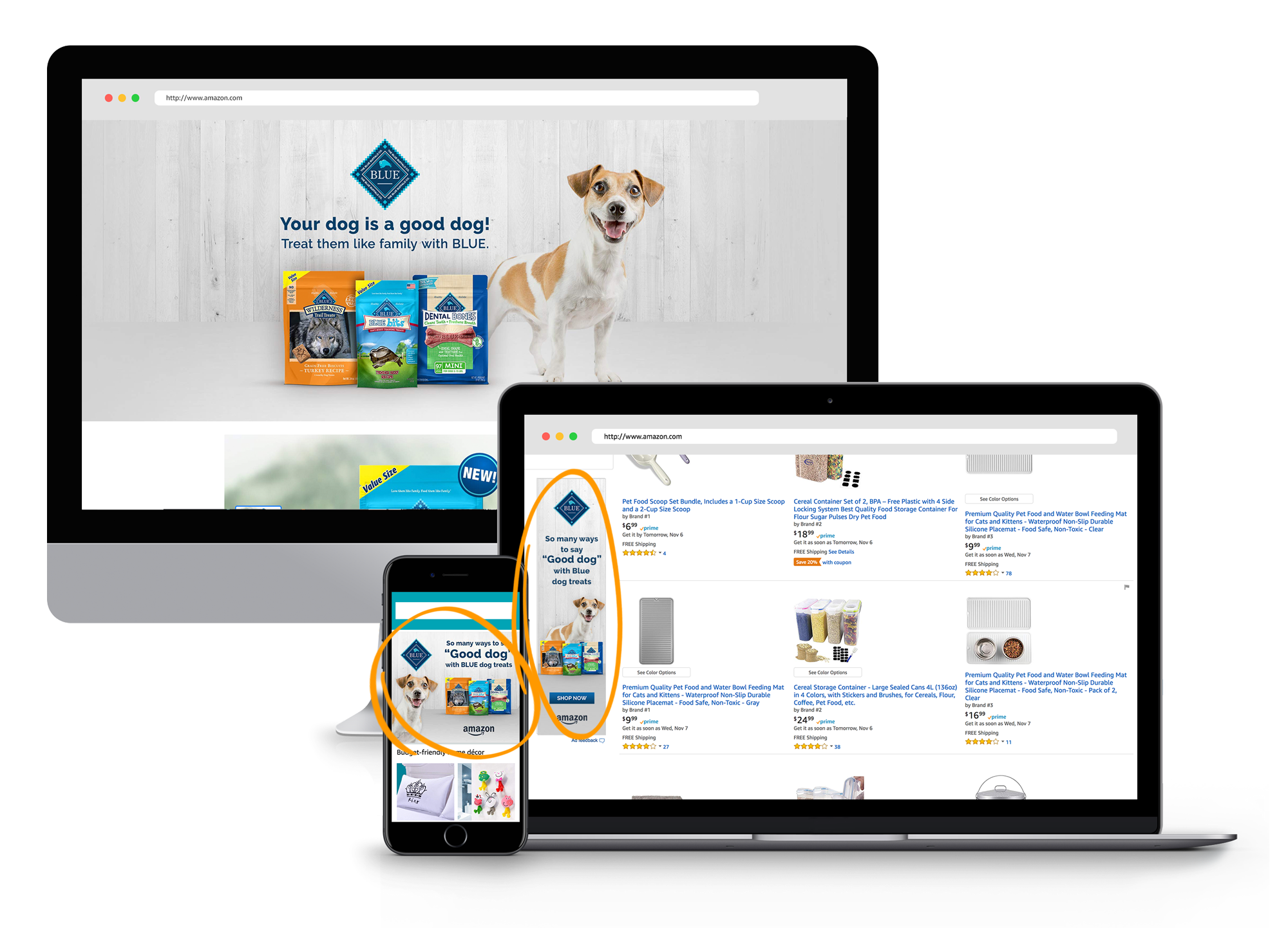
Within the display format you have the option to choose from three types and seventeen different formats, which differ in size and shape.You are free to choose the specific content and images which make up your display ads, allowing you to create display ads which match your corporate design and create recognition value for your brand.
The three different types are the following:
1. Standard display ads
Standard display ads can be seen on desktop, as well as mobile, smartphone and tablet displays. They thus appear within websites that are viewed on these devices.
This display type is available in seven different sizes.
2. Mobile app and banner ads
As the name suggests, mobile app and banner ads appear within apps on smartphone or tablet devices.
They can be booked in four different formats. Dynamic content such as video and audio content can also be placed within your ads, though this only works for third-party apps and not Amazon's own apps.
3. Mobile interstitial ads
So-called mobile interstitial ads can be displayed on both smartphones and tablets, and will take up the screen either fully or partially for a few seconds. The content of a website or app is thus pushed into the background and can no longer be seen without restrictions. These ads can be actively clicked away once they appear.

The fact that all of us are probably used to seeing display ads in the typical banner form is also their major disadvantage. Due to the frequency of their placement on websites, they are often no longer consciously noticed by visitors. Ads which appear as pop-ups, such as mobile interstitial ads, are also often perceived as annoying and are consciously clicked away. Due to such unconscious perception of banner content, the typical key figures used to measure the success of Pay-per-click ads are therefore not as applicable to display ads, and the two types of ads should certainly not be directly compared using such key figures. The click-through rate (CTR) in most display campaigns will be far worse than in PPC campaigns, for example.
No doubt, you are probably asking yourself, ‘what, then, is the point of this form of advertising?’ And more so, how can Amazon DSP ads become successful and how can that success be measured?
As already indicated, the content of banner ads is often deliberately not perceived. Unconsciously, however, these ads are very well noticed.
The brand, product or company depicted in your display ad will be (unconsciously) remembered by the people who see your ad. If they already know your company, the recognition value will provide a memory effect. If they don't know your company yet, the ad is the first touchpoint that people have with you or your brand. The goal is to achieve several touchpoints in order to get into the conscious perception of such consumers and then be recognized. Indeed, the best result is that before making a purchase decision, a visitor remembers your company and searches for your products, or they see your banner ad during a concrete product search in the purchase decision process. The recognition value of your banners can contribute to a positive feeling amongst customers to both your company and the idea of future purchases. The so-called mere-exposure effect is responsible for the fact that the more often we come into contact with an entity, the more we prefer it over others. Display ads profit from this effect; according to the motto: "I have seen this company a lot, it certainly offers great goods".
Therefore, the number of interactions is an important figure for display ads. Of course, such ads can also lead to increased sales. However, this can often be a more complex relationship to demonstrate, with sales not easily directly attributable to display-ad interaction as they may often occur at a later point in time and not immediately subsequent to a consumer "clicking" on an ad.
In order to stand out from the mass of display ads and, most of all, to be consciously noticed by potential customers, you can use "Rich Media Ads". These are characterized by dynamic elements such as audio or moving images. Indeed, this brings us onto an exploration of the next type of ad, the video ad, which can be integrated into display ads
Video ads
Video ads generate a higher level of attention from viewers because there are moving picture elements and/or music and sounds suddenly appearing.
They can either be integrated within display ads (outstream) or placed before, during or after a stand-alone video (instream). The latter is often seen on YouTube, for example, where the actual video is then paused for the duration of the video ad. Video ads can be up to 3 minutes long, but we recommend keeping it shorter. In general, instream videos are more interesting for larger brands, who can use them to complement their TV or Out-Of-Home campaigns.
Amazon offers brand safety for these videos, which means that the videos are only displayed on Amazon's own entertainment platforms (like Fire TV). This prevents videos from coming into contact with dubious platforms.
The placement of videos within display ads is currently only possible for ads which are displayed on Amazon websites, and not yet for third-party sites.
Like the display mobile interstitial ads, there are also video mobile interstitial ads that can be displayed across the entire screen.
The general rule with this form of ad is that the videos should not be too long: a length of 15 - 30 seconds is recommended.This is an ideal length for accommodating a sufficient amount of content, without appearing so long that it loses a viewer's attention.
Creatives
Amazon offers different "creatives" for the presented formats, such as images, which you can create and upload yourself (or with a graphic designer). Thus, advertisements can be designed to match your own corporate design.
Differences to Amazon PPC advertisements
Before giving you recommendations and insights into whether we think Amazon DSP is right for your company, we would like to briefly point out the key differences with Amazon PPC ads.
These are six main differences:
1. Placement
DSP Ads are displayed on Amazon's own websites, apps and devices.
In addition to the Amazon sales platform, Amazon owns other websites and shops such as Audible, Zappos, IMDb, etc.
Devices that Amazon sells include Amazon Echo, Kindle and the Fire Tablet.
The big difference to the Sponsored Product Ads and Sponsored Brands is that DSP ads can also be displayed on third-party sites.
However, Sponsored Display Ads released in October 2019 can also be displayed on third-party sites - these are not booked via the DSP but via Seller Central or the Advertising Console. However, such ads are still in the beta phase and some uses are only available to a limited number of advertisers. For more information about Sponsored Display Ads, read our article.
2. Linking
Another difference between DSP and PPC ads concerns linking. Specifically, Sponsored Products Ads, Sponsored Brands and Sponsored Display Ads can only link to Amazon sites, whilst DSP display ads can additionally link to other external sites (such as your own online shop, corporate website, etc.).
3. Seller status
A further special feature of the DSP is that you do not have to sell on Amazon in order to use it. In contrast, an Amazon seller or vendor status is a prerequisite for the placement of PPC ads.
4. Billing model
Billing and payment for Sponsored Product Ads, Sponsored Brands and currently also Sponsored Display Ads is done via the well-known Pay-per-Click method. As an advertiser, you therefore only pay for the clicks on your PPC ads, with the Cost-per-Click (CPC) calculated on the basis of your bid and the bids of your competitors.
Conversely, ads booked via the DSP are billed via the Cost per Mile (CPM) method. This means that you pay per thousand impressions of your ads and therefore for the impressions and not for the clicks.
5. Design options
The design possibilities of PPC advertisements are very limited, as your advertisement is automatically created from individual pre-defined elements. Depending on which ad you create, for example, elements might include the product image(s), a title, your logo, star rating, a price and Amazon's yellow call-to-action button. There is no option to individualise your advertisement designs with custom elements.
In contrast, you can customize the display and video ads that are placed via the DSP, such as using your own images or logos as part of a custom corporate design.
6. Sales funnel audience
You should place different types of ads depending upon which specific group of customers you are seeking to target. Display and video ads displayed on third-party websites, for example, are generally much more suitable when targeted towards people who are at the beginning of the buyer decision process. By contrast, if a person is reading on a news website, their main intention is likely going to be gathering information, and thus if they see a display ad whilst reading an article, they will be unlikely to perceive it consciously, since they are not in fact actively looking for a product.
The situation is different for ads within the Amazon platform. Since it is a sales platform, customers usually have a search and purchase intention when they visit the site, and as such, ads are - as long as they concern products relevant to what they are searching for - perceived more consciously by visitors.

In general, it can be said that display and video ads are more suitable for attracting attention and thus concern the first step in the customer journey, general awareness. Retargeting is an exception, as if customers have already searched for or purchased a certain product, it can be assumed that they already have a concrete interest in that product or similar products. By extension, retargeting with display and video ads also often works in such cases because visitors are typically more likely to notice ads from companies with whom they are already familiar, than from those with whom they have not yet had any contact.
DSP registration and format creation
It should be stated from the get-go that the (successful) use of Amazon DSP is not as easy as creating PPC ads. Indeed, it is for this reason that we would like to share our experience in using Amazon's DSP with you.
The DSP can be seen as a kind of premium "product" from Amazon, because not every company gets access to it. There are two possible routes into registering for and using the DSP:
1. Amazon managed-service
2. Enterprise self-service
Managed-service
With the DSP managed-service, you will receive support from Amazon employees to correctly create and manage your ads. For this, advertising spendings of at least 35,000 USD per month are necessary, given that such a level of support would otherwise be unprofitable for Amazon. This service is therefore more suitable for larger brands with a correspondingly large budget, assuming of course that they have little knowledge of DSPs themselves.
Enterprise self-service
As the name suggests, with the self-service option you have to take care of the DSP ads yourself. Amazon employees do not support the advertisers in this. Amazon recommends that companies wishing to serve DSP ads have a minimum budget of $10,000 per month for at least 3 months to make DSP worthwhile.
That said, not every company gets access to Amazon’s DSP and the Self Service offer. Only a company with appropriate expertise, e.g. an agency or service provider from the Amazon area, can apply for DSP access. After successful admission, they can then take over the creation and support of DSP ads for companies as a service for a fee.
We are approved for Amazon DSP and can support you with advertising using the DSP.
Registration process
The registration process is relatively time-consuming and can take months, since Amazon checks carefully the companies it allows and does not allow to use its DSP. In addition to proof of DSP expertise and a credit check, a six-figure media budget is also required. If any of these prerequisites are not met, Amazon reserves the right to impose fines on the advertiser.
DSP - advantages and disadvantages
Amazon DSP, like every advertising option, has both advantages and disadvantages, which we would like to present here in a short and concise way.
Advantages
- Brand perception for new customers
With an attention-grabbing display or video campaign, you can quickly achieve significant reach and increase awareness by being displayed on a large number of websites simultaneously.
- Placement based on Amazon customer data
The enormous amount of customer information that Amazon has access to is definitely a big advantage for advertisers, as it enables more specific audience targeting. Neither Facebook nor Google have data on purchasing behavior, exemplifying an advantage of Amazon DSP over the Google Display Network (GDN), for instance. The interests of customers are determined on the basis of theirAmazon buying and search behaviour. This data can then be used for the targeting of DSP campaigns.
However, it must be said that this advantage can actually only be "proven" by testing and directly comparing the performance figures of two separate display campaigns, for example, one hosted on Amazon DSP and the other using the GDN.
- Use of retargeting
Through Amazon DSP you can use the aforementioned method of retargeting to address people who have already been in contact with your products. People’s perceptions of these ads can be both positive and negative. A representative German study by GreenAdz suggests that retargeting should be used wisely. This is since 68 percent of those surveyed said that the advertising displayed was inappropriate for them because they were no longer interested in the product or had already bought it, with 41 percent of the participants having found the displayed advertising helpful. Therefore, if a retargeting campaign is created correctly (e.g. with placement stopping after a purchase), it can achieve good results in terms of positive brand perception and CTR. According to 99firms, retargeting ads have a CTR ten times higher than "standard" display ads.
Disadvantages
- Performance measurement
As with many advertising campaigns, measuring the success of DSP ads is not easy. Unlike PPC ads, which clearly aim to increase sales and can be directly attributed to specific purchases, DSP ads are primarily designed to build reach and image. The number of impressions can be measured but whether such impressions actually generate a positive brand image is harder to measure.
Sales are also difficult to trace back to display and video ads, as these are often only one part of the purchase decision process and are not solely responsible for any given purchase. As a result, the conversion rate is often significantly worse than with PPC ads. If a site visitor sees your display ad, doesn't click on it, remembers it, and days later a search engine lands them on your site and they make a purchase, that purchase will not be reflected in the conversion rate of the display ad - even though in practice it has contributed a great deal to the subsequent visit to your site and the subsequent purchase.
- Registration process and usability
We also see the rather lengthy and time-consuming registration procedure created by Amazon’s process for allowing access to its DSP as a disadvantage. Only after Amazon has checked and approved an applicant company will it be granted access.
Once access has been granted and the DSP can be used, a certain amount of time must also be allowed for familiarization with the platform at the beginning. Due to the many setting options and the not very user-friendly design, the DSP is anything but intuitive to use. With high budgets, the platform should therefore be used with caution. Alternatively, and recommended by us, one leaves the work to Amazon or a service provider with access like BidX.
- Costs
Cost is also an important consideration when it comes to deciding whether or not to use Amazon DSP. Even if you do not have to spend the minimum budget of 35,000 USD for self-service, Amazon recommends a budget of 10,000 USD over at least 3 months. This would also be our recommendation, as advertising success is only achieved after a certain number of ad placements. In contrast to PPC ads, this budget has to be raised in advance for some service providers, i.e. they cannot pay subsequent to engagement with the ad or with revenues that might have been generated by the ad. In addition, there may be costs for creative or video production if you work with external service providers. Especially for smaller brands, the use of DSP is often not possible due to these costs.
DSP recommendation - YES or NO?
Now we have arrived at what is probably the most important question for you: Do we recommend the use of Amazon DSP or is it a waste of money?
Our answer:
As long as you pay attention to certain things and have enough knowledge about how campaigns work and how to create them, we can definitely recommend Amazon DSP.
Our recommendations and the things to consider regarding DSP:
- Be aware that DSP campaigns will not primarily increase sales. Although retargeting can be used to target customers at the second to fourth level of the sales funnel, the primary goal of DSP campaigns is to generate attention for the brand and company products. Sales often cannot be attributed directly to DSP advertising, with click-through and conversion rates most likely lower than with your PPC campaigns as a result.
- Have a sizable budget, but don't overspend. In order for DSP campaigns to be worthwhile, you should have at least a 3,000 EUR budget available each month for at least 3 months. It does not make sense, however, if you have to "scrape together" your entire advertising budget for this purpose. If your budget is lower than this recommended value, it is likely better to use it for PPC campaigns, as these will result in a higher conversion rate. As soon as a larger advertising budget becomes available, you can then direct funds to test DSP advertising.
- Pay attention to placements on third-party websites. Although Amazon offers brand safety, this does not always guarantee that your ads will be displayed exclusively on high-quality websites. However, this is important for the perception of your business. The so-called halo effect ensures this.
The halo effect means that characteristics of a person or brand are perceived more positively (or negatively) when displayed alongside a distinct characteristic which is perceived positively (or negatively). Applied to DSP advertising, this means that your ads will be perceived as higher quality when displayed on a high-quality website. This effect was confirmed in a study by Integral Ad Science, which measured the brain activity of subjects while viewing different ads.
- Be sure to use frequency capping for retargeting campaigns. This allows you to determine the maximum number of times a person can view your ads over a specified period of time. In this way you can prevent visitors from feeling annoyed by your brand. We recommend setting the cap to 3-5.
- Look for a service provider you trust. Since you need an approved DSP service provider, ask them for their management fees (at Amazon they are 15%) and the minimum budget they need for campaign creation. Also be sure to ask them for reference projects to get an impression of the quality of their services, as any competent service provider should be aware of the tips expressed above.
If you are interested in DSP and have questions about our services, please contact us by e-mail at hello@bidx.xyz.
